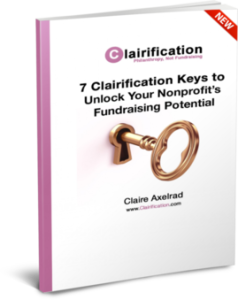In A dollar more (vs. a dollar less) Seth Godin provocatively suggests you consider a race to the top.
This made me immediately think of the nonprofit overhead conundrum. Too many nonprofits feel stuck with trying to justify the amount of money they spend on staff and infrastructure in a race to lure more donors to their cause.
The common wisdom (really nonsense) is that “a dollar less” is good. That the less you spend, the more effective you are. “Lean and mean” is supposed to be a good thing.
Folks, lean and mean is just that. Mean.
It’s not fair. It short-changes those you’re allegedly helping. It short-changes the staff who are helping them.
It leads to an untenable nonprofit starvation cycle that makes no one happy.
Staff turnover is high. Work becomes more expensive, not less, as years of experience are lost. Penelope Burk’s Donor-Centered Leadership reveals it takes an average of 14 months to get a new employee up to speed. So if they leave before that period elapses, or shortly thereafter, you never get any real productive work out of them.
Not smart.
Godin asks how Lyft can possibly compete with Uber since scale is often the secret to a commodity business, and if Lyft races to be ever cheaper than Uber, the only possible outcome doesn’t look good. It’s a cutthroat corner-cutting race.
Is your overhead low because you’re the biggest in your field and can benefit from economies of scale? Lucky you! You’re able to tout how low your overhead is and make your competitors look crummy.
But I wish you wouldn’t. It’s bad for the public benefit sector. Which is bad for the world. So think about that.
Charity needs to be judged from a different perspective.
Not how little or much you spend, but how little or much you achieve. You, and your donors, should really be looking at two things: (1) what is needed to do the job and (2) what is accomplished. Period.
SO… whether you’re a big kahuna in your field or a small fry, how about following Godin’s advice to race to the top instead?
In other words, what if Lyft were to say, “We’re always a dollar more than Uber, because we spend that on our drivers”? Wouldn’t you patronize the company that takes care of their staff, assuring they can have a living wage and benefits? And assuring that staff are not stressed out, so they can do a really good job of serving their customers?
What would happen if you were to say “our overhead reflects the high quality of our staff and infrastructure, assuring we deliver results in the most effective way possible – lasting solutions that don’t skimp on positive outcomes?”
Do you think donors would say, “Forget that…? I’d rather support the charity that offers the ‘el cheapo’ solution?”
Cutting corners just to “look good” to your donors is not going to get the job done.
It’s like cutting your medications in half because you can’t afford them. One aspirin won’t take away your head-ache if you need two.
Measuring overhead does not neatly correlate with a nonprofit’s impact or effectiveness.
As I’ve suggested before, don’t you believe donors would pay 20 cents to buy a bag of fresh, nutritious produce (that will last a full week) vs. 10 cents to buy a bag of old and rotten vegetables?
A charity that spends 20% on overhead and knocks its mission out of the ballpark is not less worthy of support than one that spends 10% on overhead but helps relatively few people. It’s one way of assessing things, but not necessarily the most meaningful.
As Godin suggests, don’t worry about your cost of overhead so much. It’s not about the cost. It’s about how much that cost is worth.
Please share your thoughts in the comments, below.
Want to Manage Your Work More Effectively?

Show donors why the value you offer is better than anyone else’s
Image courtesy of Freedigitalphotos.net
Grab the 7 Clairification Keys and unlock your nonprofit’s fundraising potential through a series of “clairifying” worksheets and individual and group exercises. (1) Values. (2) Stories. (3) Brand. (4) Social Channels. (5) Support Constituencies. (6) Engagement Objectives. (7) Resources and Systems. Spend some time being genuinely thoughtful about your goals. You’ll be glad you did — or your money back! Grab your E-Guide here.







THANK YOU!! So true. My NP is finally getting this. We are still very short staffed, but over the last year have budgeted money to let an expert do what they do best instead of expecting two staff members to do everything and constantly be in a state of trying to learn new skills, meanwhile the board is still dreaming we can expand. The metaphor I used with them was that we are like someone who wants to grow into a giant, oblivious to the fact that we are teetering on tiny feet. Infrastructure costs money. Doing it right also is much more attractive to the kind of donors and board members that you want to attract. But we (myself, ED and the Secratary/Treasurer, also had to be willing have some difficult, very honest conversations and to stand our ground.
Thanks for your comment. There’s nothing wrong with budgeting for growth, but the leaders (ie. board) need to understand that a growth mindset entails them stepping up to assure the financing is there to make growth possible. I’m glad you’re bringing in some seasoned talent. Good luck!
Good stuff. The way some try to obfuscate and cover up development work all for the sake of keeping low overhead is crazy. We need to be having serious conversations with funders and donors about this. Thanks –
And some standardization of what counts as “overhead” wouldn’t hurt either. Thanks for the comment!
Claire,
This is a great article. Our non-profit is in the process of an expensive overhaul of our database and accounting systems. We are little, and we don’t want to become huge and have to employ many more people in order to grow. Our farsighted view is that the only way we can grow and serve more people is to automate our backend processes. Initially it takes so much energy, but in the end, the goal is to have much more capacity for service. Also, it’s true that losing good people because of sacrificial level wages is very expensive! We need hungry, humble and smart team members, and when we find them we want to keep them. Of course they could make more in the private sector. But we have to be humane, fair, and realistic about what it costs to live.
Thanks for the encouragement,
Patti Defilippis
Saint Luke Productions
Kudos to you for recognizing it costs money to be effective and fair. If we don’t work smart, we short-change our mission and our supporters.